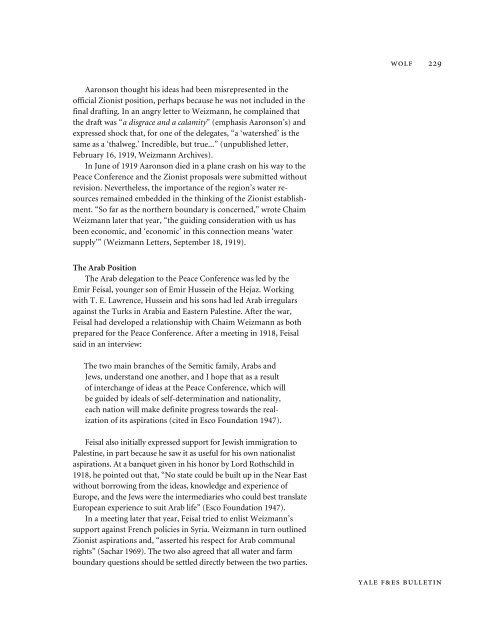Hydrostrategic Decisionmaking and the Arab ... - Yale University
Hydrostrategic Decisionmaking and the Arab ... - Yale University
Hydrostrategic Decisionmaking and the Arab ... - Yale University
Create successful ePaper yourself
Turn your PDF publications into a flip-book with our unique Google optimized e-Paper software.
WOLF 229Aaronson thought his ideas had been misrepresented in <strong>the</strong>official Zionist position, perhaps because he was not included in <strong>the</strong>final drafting. In an angry letter to Weizmann, he complained that<strong>the</strong> draft was “a disgrace <strong>and</strong> a calamity” (emphasis Aaronson’s) <strong>and</strong>expressed shock that, for one of <strong>the</strong> delegates, “a ‘watershed’ is <strong>the</strong>same as a ‘thalweg.’ Incredible, but true...” (unpublished letter,February 16, 1919, Weizmann Archives).In June of 1919 Aaronson died in a plane crash on his way to <strong>the</strong>Peace Conference <strong>and</strong> <strong>the</strong> Zionist proposals were submitted withoutrevision. Never<strong>the</strong>less, <strong>the</strong> importance of <strong>the</strong> region’s water resourcesremained embedded in <strong>the</strong> thinking of <strong>the</strong> Zionist establishment.“So far as <strong>the</strong> nor<strong>the</strong>rn boundary is concerned,” wrote ChaimWeizmann later that year, “<strong>the</strong> guiding consideration with us hasbeen economic, <strong>and</strong> ‘economic’ in this connection means ‘watersupply’” (Weizmann Letters, September 18, 1919).The <strong>Arab</strong> PositionThe <strong>Arab</strong> delegation to <strong>the</strong> Peace Conference was led by <strong>the</strong>Emir Feisal, younger son of Emir Hussein of <strong>the</strong> Hejaz. Workingwith T. E. Lawrence, Hussein <strong>and</strong> his sons had led <strong>Arab</strong> irregularsagainst <strong>the</strong> Turks in <strong>Arab</strong>ia <strong>and</strong> Eastern Palestine. After <strong>the</strong> war,Feisal had developed a relationship with Chaim Weizmann as bothprepared for <strong>the</strong> Peace Conference. After a meeting in 1918, Feisalsaid in an interview:The two main branches of <strong>the</strong> Semitic family, <strong>Arab</strong>s <strong>and</strong>Jews, underst<strong>and</strong> one ano<strong>the</strong>r, <strong>and</strong> I hope that as a resultof interchange of ideas at <strong>the</strong> Peace Conference, which willbe guided by ideals of self-determination <strong>and</strong> nationality,each nation will make definite progress towards <strong>the</strong> realizationof its aspirations (cited in Esco Foundation 1947).Feisal also initially expressed support for Jewish immigration toPalestine, in part because he saw it as useful for his own nationalistaspirations. At a banquet given in his honor by Lord Rothschild in1918, he pointed out that, “No state could be built up in <strong>the</strong> Near Eastwithout borrowing from <strong>the</strong> ideas, knowledge <strong>and</strong> experience ofEurope, <strong>and</strong> <strong>the</strong> Jews were <strong>the</strong> intermediaries who could best translateEuropean experience to suit <strong>Arab</strong> life” (Esco Foundation 1947).In a meeting later that year, Feisal tried to enlist Weizmann’ssupport against French policies in Syria. Weizmann in turn outlinedZionist aspirations <strong>and</strong>, “asserted his respect for <strong>Arab</strong> communalrights” (Sachar 1969). The two also agreed that all water <strong>and</strong> farmboundary questions should be settled directly between <strong>the</strong> two parties.YALE F&ES BULLETIN
















